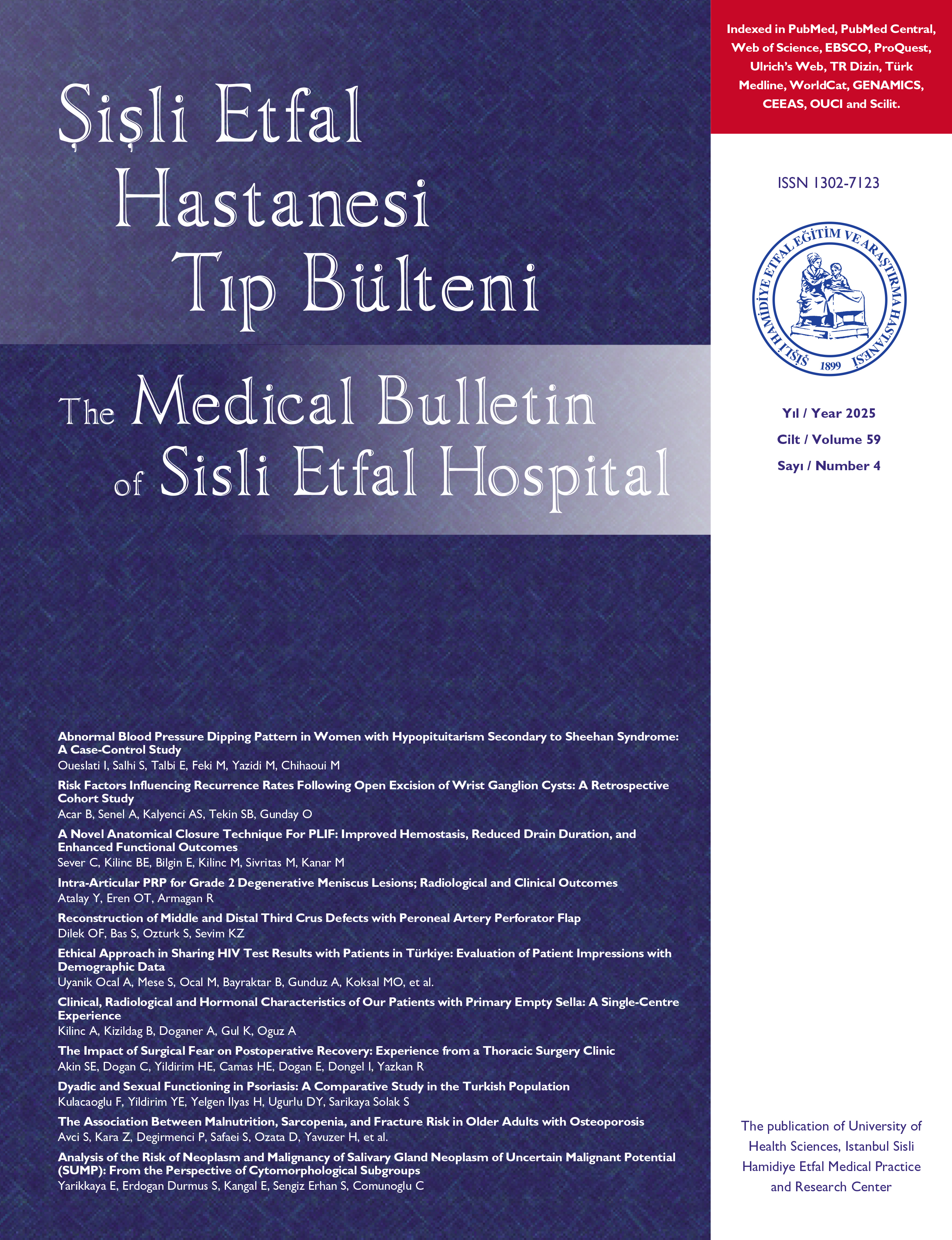
Determining INR Awareness of the Patients who Use Warfarin and Rates of Achieving the Target Dosage
Nazan Demir1, Sumeyra Yildirim Yucelen2, Elif Guven Cetin1, Kubra Kalkan3, Yuksel Asli Ozturkmen1, Esra Demir4, Aslihan Calim1, Fatih Borlu1, Yuksel Altuntas5, Sema Basat61Department of Internal Medicine, University of Health Sciences Turkey, Sisli Hamidiye Etfal Teaching and Resarch Hospital, Istanbul, Turkey2Department of Internal Medicine, Acibadem Kadikoy Hospital, Istanbul, Turkey
3Department of Internal Medicine, University of Health Sciences Turkey, Bakirkoy Dr. Sadi Konuk Training and Research Hospital, Istanbul, Turkey
4Department of Internal Medicine, University of Health Sciences Turkey, Kanuni Sultan Suleyman Training and Research Hospital, Istanbul, Turkey
5Department of Endocrinology, University of Health Sciences Turkey, Sisli Hamidiye Etfal Teaching and Resarch Hospital, Istanbul, Turkey
6Department of Internal Medicine, University of Health Sciences Turkey, Umraniye Training and Research Hospital, Istanbul, Turkey
Objectives: Warfarin is the most frequently used therapy as an oral anticoagulant medication for reducing the risk of thromboembolic complications. However, poor adherence to therapy may cause ineffective INR levels with increased complication risk. In our study, we aimed to show the rates of INR awareness of patients with atrial fibrillation (AF) using warfarin and whether they achieved the targeted INR values.
Methods: In this study, 300 male (60%, n=180) and female (40%, n=120) patients over 18 years of age who applied to warfarin polyclinic and were receiving warfarin treatment due to AF were included. The levels of INR between 2-3 were estimated as effective. Same questionnaire was applied to all patients.
Results: Our study showed that 57% of the patients who used warfarin were not in the therapeutic range. We also determined that INR awareness was extremely low in the majority of the patients. In this study, 72.2% of the patients who used warfarin did not know the definition of INR, 68% of the patients did not know the side effects of the medicine, 75.7% of the patients did not know the precautions needed to be taken in daily life and 83.7% of the patients did not know the foods rich in vitamin K. Patients who knew the meaning of INR were more likely have INR levels in the effective range, but these rates were not statistically significant. There was no statistically significant relationship between the educational level, marital status, and INR control frequency of the patients with the achievement of targeted INR levels.
Conclusion: At the beginning of the warfarin treatment, advantages and disadvantages should be balanced by the doctor. The patient and patients relatives should be informed directly and comprehensibly about the effects and side effects of the medicine, as well as the interactions, pursuance and precautions need to be taken in daily life. Various modern methods should be enabled for surveillance and the patients who are not in the therapeutic range should be followed closer.
Keywords: Drug compliance, INR; warfarin.
Varfarin Kullanan Hastalarda INR Farkındalığının Ve Hedeflere Ulaşma Oranlarının Belirlenmesi
Nazan Demir1, Sumeyra Yildirim Yucelen2, Elif Guven Cetin1, Kubra Kalkan3, Yuksel Asli Ozturkmen1, Esra Demir4, Aslihan Calim1, Fatih Borlu1, Yuksel Altuntas5, Sema Basat61Department of Internal Medicine, University of Health Sciences Turkey, Sisli Hamidiye Etfal Teaching and Resarch Hospital, Istanbul, Turkey2Department of Internal Medicine, Acibadem Kadikoy Hospital, Istanbul, Turkey
3Department of Internal Medicine, University of Health Sciences Turkey, Bakirkoy Dr. Sadi Konuk Training and Research Hospital, Istanbul, Turkey
4Department of Internal Medicine, University of Health Sciences Turkey, Kanuni Sultan Suleyman Training and Research Hospital, Istanbul, Turkey
5Department of Endocrinology, University of Health Sciences Turkey, Sisli Hamidiye Etfal Teaching and Resarch Hospital, Istanbul, Turkey
6Department of Internal Medicine, University of Health Sciences Turkey, Umraniye Training and Research Hospital, Istanbul, Turkey
AMAÇ: Çalışmamızda atriyal fibrilasyonlu (AF), varfarin kullanan hastalarda INR (international normalized ratio) farkındalığının ve bu hastalarda hedeflenen INR düzeyine ulaşma oranlarının belirlenmesini amaçladık.
MATERYAL VE METOD: Çalışmamıza varfarin polikliniğine başvuran, AF nedeniyle varfarin tedavisi alan, 18 yaş üstü kadın (%40, n: 120) ve erkek ( %60, n: 180) toplam 300 hasta dahil edildi. INR açısından 2-3 ve arası değerler efektif olarak değerlendirildi. Hastaların tamamına aynı anket uygulandı.
BULGULAR: Varfarin kullanan hastaların %57sinin istenilen efektif INR düzeyinde olmadığını gösterdik. Yine hastaların büyük çoğunluğunda INR farkındalığını oldukça düşük saptadık. Nitekim varfarin kullananların %72.2si INRnin ne anlama geldiğini, %68i ilacın yan etkilerinin neler olduğunu, %75.7si günlük hayatta alması gereken önlemlerin neler olduğunu, %83.7si ise K vitamini içeren besinlerin neler olduğunu bilmemekteydi. INRnin anlamını bilen hastaların, efektif INR aralığında bulunma oranları daha yüksek saptanmasına karşın bu oranlar istatiksel olarak anlamlı saptanmadı. Ayrıca eğitim düzeyi, medeni durum ve INR baktırma sıklığı ile INR hedef değerlerine ulaşılması arasında da istatiksel olarak anlamlı bir ilişki bulunmadı.
SONUÇ: Varfarin tedavisi başlangıcında hekim tarafından kar-zarar dengesi iyi kurulmalı, hasta ve yakınlarına ilacın etkileri, yan etkileri, etkileşimleri, takibi, günlük hayatta alınması gereken önlemler vb. konularda direkt, anlaşılabilir bir şekilde bilgi verilmelidir. İzlem için çeşitli modern yöntemler her şekilde devreye sokulmalı ve INR düzeyi istenen düzeyde olmayan hastaların takibi daha yakından yapılmalıdır. (SETB-2018-08-116)
Anahtar Kelimeler: Varfarin, INR, ilaç uyumu
Manuscript Language: Turkish



















